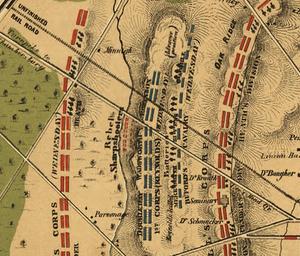At Gettysburg, despite that the regimental roster on the Pennsylvania Monument indicates, [DeLacy] was still a corporal–at best, an acting sergeant.
On July 1, the marching rotation for the First Corps called for Maj. Gen. Abner Doubleday’s Third Division to lead the march. There did not seems to be any unusual hurry in the camp on the morning of the first, but Maj. Gen. John Reynolds decided to have Brig. Gen. James Wadsworth’s First Division march with him as he rode forward to see what was happening on Brig. Gen. John Buford’s front. The First Division had been on the march on June 30, and had camped a mile or two closer to Gettysburg than the divisions of Doubleday and Brig. Gen. John Robinson. The shorter marching distance for the First Division may have been a factor in Reynolds’ selection. Reynolds may also have wanted his most expeienced division with him in the event tha there was going to be an immediate fight.
Doubleday’s Third Division, commanded by Brig. Gen. Thomas Rowley, was next in order of march, but did not go up the Emmitsburg Road as did the First Division. Rather, both fo the two brigades that were present marched basically north from their campaign areas of June 30. They then moved east, and finally north again until they reached the area of the Lutheran Seminary [in Gettysburg] where the fighting of July 1 took place.
Col. Roy Stone’s Second Brigade of the Third Division – including the 143rd PA with DeLacy in its ranks – received its marching orders about 8 a.m. and conducted a deliberate march to Gettysburg. The march started from the Brown farm, northwest of Marsh Creek at about 9 a.m. The Second Brigade marched north along Red Rock Road to the Millerstown Road, turned right and continued marching east on the Millerstown Road past the Pitzer Schmoo to the intersection of the Emmitsburg Road. The brigade had turned left on the Emmitsburg Road and was marching north when the men first head the sounds of cannon fire. Almost simultaneously, a staff officer rode up to Col. Stone with orders to have the men hurry forward. Stone ordered the brigade to double quick. Shortly after, the brigade reached the point across the Codori Farm on the Emmitsburg Road where the units of the First Corps that had preceded Stone’s Brigade had cut cross-country over the Spangler and Bliss farms. Stone’s men followed this shortcut, and within another quarter hour the front of the brigade reached the fields west of the Seminary.
The original deployment of the brigade was along west McPherson’s Ridge from south to north. The 150th PA was nearest to the Herbst Woods; the 143rd PA was in the middle; and the 149th PA continued north, extending past the McPherson farm buildings to the Cashtown Road. In these positions, the three reigments proided cover to the right flank on the Iron Brigade, but the right flank of Stone’s Brigade was now in the air since the closest of the regiments in Cutler’s Brigade was about 1/4 mile north and east of Stone’s position.
Once the brigade had been deployed, Col. Stone ordered skirmishers posted. Initially three companies of skirmishers and one group of sharpshooters were sent forward. These included Co. B (Capt. George Jones) of the 150th PA, Co. A (Capt. Charles Conyngham) and a detail of 30 sharpshooters (Capt. R. Crockett) from the 143rd PA, Co. K (Capt. Zarah McCullough) was also posted on the right of the skirmishers, about halfway down the slope of the Cashtown Road [Chambesburg Pike] between McPherson’s Ridge and Willoughby Run. Losses in Co. A of the 143rd were small (1 killed, 1 mortally wounded), but the losses among the sharpshooters who deployed on the western side of Willoughby Run included 24 killed and wounded out of 31 deployed.
There were two interesting occurrences on the skirmish line of Co. A on the first day. Herbert M. Nogle saved a wounded comrade, Sgt. William Bennett, by carrying him out of harm’s way near Willoughby Run, and bringing him up to the McPherson Barn. Ten months later he would be recipient of similar action in the flaming [Battle of the] Wilderness that would save his life. Sgt. DeLacy would exhibit somethign that would make him stand out in a crowd of soldiers. This was LUCK. While on the skirmish line, a piece of a Confederate shell hit DeLacy in the cartridge box. The result was that the blouse was ripped off his chest, leaving a number of contusions, but no serious wound.
